Stunning Patios: Enhancing Outdoor Spaces with Concrete Masonry
As the days grow longer and the warmth of spring beckons us outdoors, there’s no better time to transform your outdoor living space into a haven of relaxation and entertainment. At Sudlow Concrete, we believe that a beautifully crafted patio can be the cornerstone of your outdoor oasis, and we’re here to show you how concrete masonry can elevate your outdoor experience.

Unparalleled Durability
When it comes to outdoor surfaces, durability is key. Concrete masonry offers unmatched strength and resilience, ensuring that your patio withstands the test of time and the elements. Unlike other materials that may crack, warp, or fade over time, concrete patios retain their beauty and functionality for years to come, with minimal maintenance required.
Endless Design Possibilities
Gone are the days of drab, gray concrete slabs. Today, concrete masonry offers a world of design possibilities to suit any aesthetic preference. From stamped patterns that mimic the look of natural stone to custom colors and textures, the versatility of concrete allows you to create a patio that truly reflects your style and personality. Whether you prefer a sleek, modern look or a rustic, natural feel, our team at Sudlow Concrete can bring your vision to life with precision and artistry.
Seamless Integration
A well-designed patio seamlessly integrates with the surrounding landscape, enhancing the beauty of your outdoor space. With concrete masonry, you can create custom features such as built-in seating, fire pits, and water features that not only add functionality but also serve as focal points for gathering and relaxation. Our skilled craftsmen work closely with you to design a patio that complements your home’s architecture and enhances its overall appeal.
Environmental Sustainability
In an increasingly eco-conscious world, sustainability is a top priority for many homeowners. Concrete masonry offers inherent environmental benefits, including energy efficiency, recyclability, and low maintenance requirements. By choosing concrete for your patio project, you’re making a sustainable choice that contributes to a greener future for generations to come.
Experience the Sudlow Difference
At Sudlow Concrete, we’re passionate about creating outdoor spaces that inspire and delight. With decades of experience in the concrete masonry industry, our team has the expertise and dedication to bring your patio dreams to life. From concept to completion, we’re committed to exceeding your expectations with top-quality craftsmanship and exceptional service.
Ready to elevate your outdoor living experience? Contact Sudlow Concrete today to schedule a consultation with our team of experts. Let’s work together to create a stunning patio that transforms your outdoor space into a sanctuary of style and comfort.
Your oasis awaits…
#ConcreteMasonry #OutdoorLiving #PatioDesign #SudlowConcrete #OutdoorOasis #TransformYourSpace
How To Get Rid Of Concrete?
Getting rid of concrete can be a big job depending on the surface area of your concrete, but it’s usually necessary when you’re replacing old, cracked, or damaged concrete surfaces.
Oftentimes demolition and concrete removal can be one of the most daunting tasks of a concrete project. Whether you’re removing a driveway, patio, or other concrete structure, there are a few steps you can follow to make the process easier.
- Determine the scope of the project: Before you begin, it’s important to determine the scope of the project and the amount of concrete that needs to be removed. This will help you determine the tools and equipment you’ll need, as well as the amount of time and labor required.
- Prepare the area: Before you start removing concrete, you’ll need to prepare the area. This may include covering plants, shrubs, and other landscaping features with plastic or tarps to protect them from damage. You should also remove any obstacles or furniture that may be in the way.
- Demolition: The next step is to begin the demolition process. There are several methods you can use to remove concrete, including breaking it up by hand, using a jackhammer, or using a specialized concrete removal tool. The method you choose will depend on the size and type of concrete structure you’re removing, as well as the tools and equipment you have available.
- Disposal: Once the concrete is removed, you’ll need to dispose of it. This may involve breaking it up into smaller pieces and loading it onto a truck or trailer for removal. Alternatively, you may be able to rent a dumpster to place the concrete in for disposal. Be sure to always check with your local government to find out what the regulations are for disposing of concrete in your area.
- Clean up: After the concrete has been removed and disposed of, you’ll need to clean up the area. This may involve sweeping up any dust or debris, and removing any protective coverings that you used to protect your landscaping. You should also repair any damaged landscaping or other features that may have been impacted during the concrete removal process.
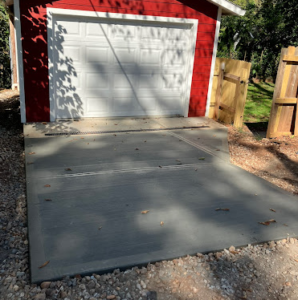
When following the steps outlined above, there are a few things to keep in mind when removing concrete:
- Safety: Always wear protective gear, such as safety glasses, gloves, and a hard hat, when removing concrete. Be aware of any electrical or gas lines that may be in the area, and take care to avoid damaging them.
- Tools and equipment: Make sure you have the proper tools and equipment for the job, including a jackhammer or concrete removal tool, as well as any necessary safety gear. If you don’t have the tools and equipment you need, consider renting them from a local equipment rental store.
- Time and labor: Removing concrete can be a big job, so be prepared to dedicate the necessary time and labor to get it done. If the job is too big for you to handle on your own, consider hiring a professional concrete removal service.
Getting rid of concrete can be a big job and definitely poses its challenges. Your local concrete professionals are always best to rely on for larger concrete projects and will make the process simple (and safe, too).
How To Remove Paint from Concrete
There are a few methods for removing paint from concrete including a pressure washer, chemical paint stripper, concrete grinder, and sandblaster. The method and material for removing the paint will depend on the size of the paint spill, porosity of the surface, and base type of paint. We will go into more detail with each method below.
Using a Pressure Washer
Using a pressure washer or power washer is the easiest and most effective method for removing paint from exterior concrete. Simply blast the paint with a high-pressure stream of water, and it should come off relatively easily. We recommend using a pressure washer with a pressure rating of at least 3000 psi. Pressure washers can be quite an investment, but you could always rent one for your paint removal job as well. Another important thing to note is that when pressure washing paint off concrete, be careful to not use a setting that is too high otherwise it may damage the concrete itself.
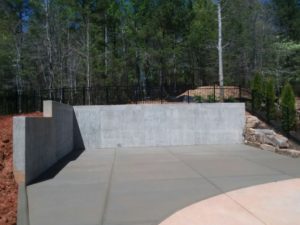
Using a Chemical Paint Stripper
Paint strippers are typically designed to remove paint from wood, but they also work wonders to loosen and remove paint from concrete surfaces as well. When choosing a paint stripper, be sure to select a paint stripper that will be effective on the type of paint spill you have – oil-based paint vs. water-based paint.
Typically you will need to let the paint stripper sit up to 24 hours so it can fully saturate the surface. Then once the paint is visibly puckered, use a scraper, putty knife, or wire brush to scrape off the softened paint. If there is any residue left on the surface, you may need to repeat the process.
Note: Be sure to always carefully follow the instructions on the product label and avoid paint strippers that contain methylene chloride, as these are highly toxic.
Using a Grinder
If the paint is particularly stubborn, you may need to use a concrete grinder to remove it. This method is more labor-intensive and can create a lot of dust and debris, so we recommend using this method as a last resort. They are, however, very effective at cleaning concrete floor surfaces. This equipment and the grinding disks are easy to rent at home improvement stores. If you are inexperienced with this method, you can also hire a professional to help with the job.
Using a Sandblaster
Sandblasting is another option for removing paint from concrete, but it can be quite abrasive and may damage the surface of the concrete if not used carefully.
Whichever method you choose above, be sure to protect yourself by wearing protective eyewear and gloves, and work in a well-ventilated area.
If Paint Will Not Come Off, Consider Concrete Resurfacing
If your paint spill is so stubborn and will not fully come off, another option to consider is concrete resurfacing. Concrete resurfacing is the process of refinishing old concrete to restore it and make it look new again.
During this process, a coating is applied over the existing concrete to make it appear new. This coating is decorative and offers a wide range of color, texture, and pattern options. A few options of resurfaced concrete could be stamped concrete, decorative aprons, stained concrete, masonry and more.
Resurfacing concrete is a great option if you are looking to cover up stained / dirty concrete, discolored concrete or other imperfections. However, if larger cracks are present in the concrete, it must be either repaired or replaced fully.
Consult with concrete professionals in your area to determine which option is best for you.
All You Need To Know About a Yard of Concrete
Trying to measure concrete yards needed for a new patio? Or a new driveway? No fear – we’re here to help. We’ve put together a one-stop-shop guide answering all of your questions around the weight of a yard of concrete, number of bags in a yard of concrete, how to determine yards of concrete, and more.
Read on and we’ll help demystify these questions so you can accurately plan for your concrete project.
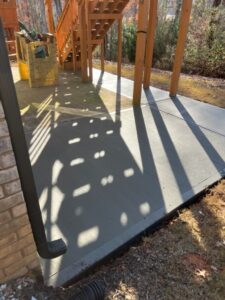
How Much Does a Yard of Concrete Weigh?
The weight of a yard of concrete can vary depending on the mix design and the moisture content of the concrete. In general, a cubic yard of concrete (which is equivalent to 27 cubic feet) weighs between 4000 and 5000 pounds, or between 2 and 2.5 tons. Concrete is made up of a mixture of cement, water, and aggregate materials, such as sand and gravel – the proportion of these materials in the concrete can affect the overall weight. For example, a concrete mix with a higher proportion of cement will generally be denser and therefore heavier than a mix with a lower proportion of cement. Similarly, a more wet mix of concrete will weigh more than a dry mix due to the added weight of the water.
To calculate the weight of a specific amount of concrete, you can use the following formula:
- Weight (lbs) = volume (cubic feet) x density (lbs/cubic foot)
For example, if you have a cubic yard of concrete with a density of 150 lbs/cubic foot, the weight of the
concrete would be:
- Weight (lbs) = 27 cubic feet x 150 lbs/cubic foot = 4050 lbs
How Many Bags of Concrete in a Yard?
The number of bags of concrete required to make a yard of concrete depends on the size of the bags and the mix design of the concrete. Concrete is typically sold in bags containing either 60 or 80 pounds of dry mix.
So for example, if you are using bags of concrete mix that contain 60 pounds of dry mix, you will need 60 bags to make a cubic yard of concrete. If you are using bags of concrete mix that contain 80 pounds of dry mix, you will need 45 bags to make a cubic yard of concrete.
To calculate the number of bags of concrete required for a specific project, you can use the following formula:
- Number of bags = volume (cubic yards) x bags/cubic yard
For example, if you need to make 1 cubic yard of concrete using bags of mix that contain 60 pounds of dry mix, you will need:
- Number of bags = 1 cubic yard x 60 bags/cubic yard = 60 bags
It is important to note that this is just a rough estimate, as the actual number of bags required may vary depending on the specific mix design and the moisture content of the concrete. It is always a good idea to have a little extra concrete on hand, just in case you need it.
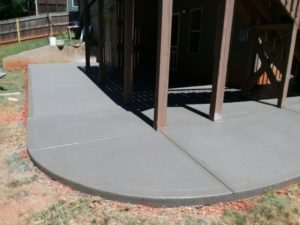
How to Figure Yards of Concrete?
To figure out the number of cubic yards of concrete required for a project, you will need to know the dimensions of the area that you need to cover and the desired thickness of the concrete.
Here are the steps you can follow to calculate the number of cubic yards of concrete needed:
- Measure the length, width, and depth of the area where you will be placing the concrete.
- Convert the dimensions to feet. If the dimensions are in inches or another unit of measurement, you will need to divide them by the number of inches per foot (12 inches) or the equivalent conversion factor for the unit you are using.
- Calculate the volume of the area in cubic feet. To do this, multiply the length, width, and depth in feet. For example, if you are pouring a slab that is 10 feet long, 20 feet wide, and 4 inches thick (which is equal to 0.33 feet), the volume would be: 10 feet x 20 feet x 0.33 feet = 6.6 cubic feet.
- Convert the volume to cubic yards. To do this, divide the volume in cubic feet by the number of cubic feet in a cubic yard (27 cubic feet). For example, if you have a volume of 6.6 cubic feet, you would need: 6.6 cubic feet / 27 cubic feet/cubic yard = 0.24 cubic yards of concrete.
Again, this is just an example, but we recommend always having a bit of extra concrete on hand just so you don’t fall short in the middle of your project.
Sudlow Concrete can always help you configure yards needed for a project, so call us today to discuss.
How To Clean Concrete Like a Pro
Before we get into the steps to how to clean concrete, the first thing to know is that you don’t need to be too delicate given that concrete is one of the most durable materials available. Even though that concrete is durable and generally low maintenance, it definitely needs a good cleaning every so often to remove build up of grease, stains, debris, and other gunk – which are notoriously difficult to get rid of.
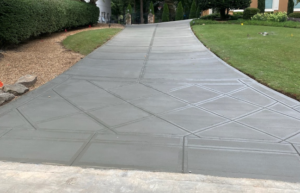
There are several methods that can be used to clean concrete driveways depending on the type of dirt or stain you are trying to remove. Below, we walk you through our most effective method of how to clean concrete step by step that can easily be done at home.
Steps To Clean Concrete
- Sweep or blow away any loose debris, such as leaves or dirt, from the surface of the concrete. This will make it easier to see and remove any remaining dirt or stains.
- Mix a solution of warm water and mild detergent in a bucket. You can also use a concrete cleaner specifically formulated for removing stains from concrete.
- Apply the cleaning solution to the concrete using a stiff-bristled brush or a pressure washer. Scrub the surface of the concrete to loosen and remove dirt and stains. If you are using a pressure washer, be sure to follow the manufacturer’s instructions for the appropriate pressure setting and keep a safe distance from the surface to avoid damaging the concrete.
- Rinse the surface of the concrete with clean water to remove any remaining cleaning solution and dirt. You can use a hose or a pressure washer to rinse the surface.
- Allow the concrete to air dry and voila!
If the concrete is severely stained or has built-up grime that cannot be removed with a mild detergent solution, you may need to use a stronger cleaning solution, such as a concrete etching product or a heavy-duty degreaser. Be sure to follow the manufacturer’s instructions and use protective gear, such as gloves and goggles, when handling these products.
Pressure Washing Concrete
A pressure washer is one of the most effective tools to use to keep a driveway clean. When setting up the pressure washer, be sure to assemble it according to the manufacturer’s instructions and fill the detergent tank with a cleaning solution specifically formulated for concrete surfaces.
We always recommend testing the pressure washer by spraying a spray pattern on a small, inconspicuous area of the driveway to ensure that it is set to the appropriate pressure and to make any necessary adjustments.
Then, you are all set to begin pressure washing: Hold the pressure washer wand at a 45-degree angle to the surface of the driveway and start at one end of the driveway. Slowly move the wand back and forth in a sweeping motion, overlapping each pass slightly to ensure that you cover the entire surface.
How Often Should A Concrete Driveway Be Cleaned?
The frequency of cleaning concrete surfaces depends on a variety of factors, including the amount of foot traffic, the weather conditions, and the presence of stains or other contaminants. For most residential and commercial concrete surfaces, a thorough cleaning every 1 or 2 years is generally sufficient.
However, surfaces that are exposed to heavy foot traffic, such as sidewalks, driveways, and patios, may need to be cleaned more frequently, especially if they are prone to staining or if they are located in areas exposed to a lot of dirt. In these cases, a cleaning every 6-12 months may be necessary.
If you notice any stains or build-up of dirt on your concrete surfaces, it is always a good idea to clean them as soon as possible to prevent the stains from becoming more difficult to remove later on. This will help you upkeep the concrete and keep it well-maintained.



